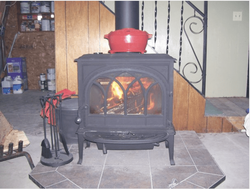Ho boy . . . first off, welcome to the forum . . . hopefully you'll stick around . . . you've got a great looking stove.
A few pointers though . . . mostly just reiterating.
Reloading a stove at 500 degrees (I assume stove top temp) is a good way to over-fire a stove. You really only want to reload a stove (especially loading it to the gills) when it is on the "downhill" swring of burning . . . when it is in the coal stages or if if's getting late, when it's close to coaling up with little active flames. For the Oslo, the Castine's bigger brother, 500 degrees stove top is the normal cruising temp . . . if I were to add a huge load of new wood at those temps what would happen would be a huge increase in temps for the stove and especially for the flue . . . especially if I went off and left the air control all the way open.
Second, congrats on the long burn time . . . but I think you would find your glass would have even less black if you reloaded the firebox at the coaling stage, brought the stove temps up to cruising "altitude" and then began stepping down the air control a quarter "turn" at a time . . . this lets the stove adjust to the reduced air control. Once you're at the quarter open "mark" you may wish to try shutting down the air all the way (technically the stove is still getting air of course) . . . if the fire continues to burn with good secondary flames for 10 minutes or so you should be good to go . . . if the secondary stalls and things begin smoking up you will want to open the air to the quarter mark and then either leave it there for the night or try to shut it down in another 10 minutes or so.
If things are good, and the wood is seasoned enough, you should be able to shut down the air control all the way "closed" and still maintain your secondary burn for longer than 10 minutes . . . and in the morning when you wake up there will be little to no black on the glass. The only time I wake up to find black on the glass is when either a) some wood has rested against the glass or b) I shut down the air too much or too soon and the fire ended up not burning as hot as it should . . . fortunately a rarity these days.
Also, as noted . . . leaving the air control all the way to the right is a big no-no . . . yes, I have no doubt the glass was clean, but in the process you risk possible over-firing of the stove and more likely you are experiencing some very hot temps in your chimney. In my own case, the normal position of the air control when I'm not right in the same room with the stove (or only stepping away for 5 minutes or so) is a quarter open . . . all the way to the right, even halfway open = me staying in the same room or only leaving the area for a maximum of 5 minutes.
One final word . . . yeah, we've beat up on you a bit . . . but the truth is . . . most of us are speaking from experience . . . from our own screw-ups . . . such as leaving the air control open half-way and leaving the stove for too long while we have showered . . . and then coming back to find the flue temp at 1,000+ and the stove top temp climbing to 700 . . . not that I've ever done that.

Live and learn from our mistakes . . . or make your own and pay the consequences. Me, I continue to hang around here since I want to keep learning.



 A couple hours later you tossed in a few big logs and all was good. The glass almost cleaned itself due to the high temperatures. I'd hope so!
A couple hours later you tossed in a few big logs and all was good. The glass almost cleaned itself due to the high temperatures. I'd hope so! Live and learn from our mistakes . . . or make your own and pay the consequences. Me, I continue to hang around here since I want to keep learning.
Live and learn from our mistakes . . . or make your own and pay the consequences. Me, I continue to hang around here since I want to keep learning.